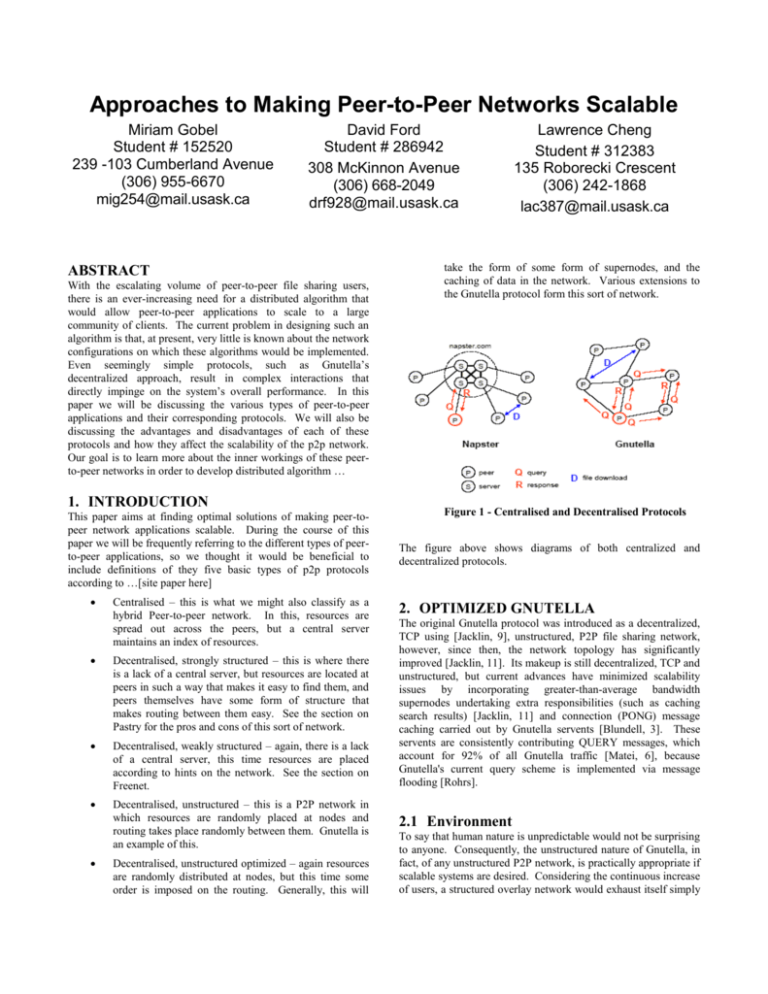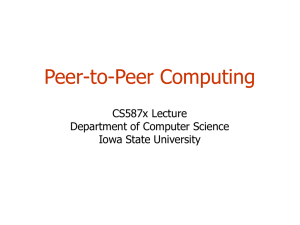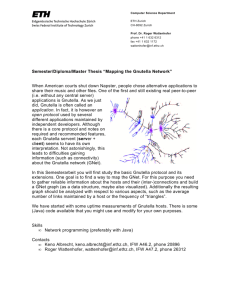3. rdf- and schema-based peer-to-peer systems
advertisement

Approaches to Making Peer-to-Peer Networks Scalable Miriam Gobel Student # 152520 239 -103 Cumberland Avenue (306) 955-6670 mig254@mail.usask.ca David Ford Student # 286942 308 McKinnon Avenue (306) 668-2049 drf928@mail.usask.ca ABSTRACT With the escalating volume of peer-to-peer file sharing users, there is an ever-increasing need for a distributed algorithm that would allow peer-to-peer applications to scale to a large community of clients. The current problem in designing such an algorithm is that, at present, very little is known about the network configurations on which these algorithms would be implemented. Even seemingly simple protocols, such as Gnutella’s decentralized approach, result in complex interactions that directly impinge on the system’s overall performance. In this paper we will be discussing the various types of peer-to-peer applications and their corresponding protocols. We will also be discussing the advantages and disadvantages of each of these protocols and how they affect the scalability of the p2p network. Our goal is to learn more about the inner workings of these peerto-peer networks in order to develop distributed algorithm … 1. INTRODUCTION This paper aims at finding optimal solutions of making peer-topeer network applications scalable. During the course of this paper we will be frequently referring to the different types of peerto-peer applications, so we thought it would be beneficial to include definitions of they five basic types of p2p protocols according to …[site paper here] Centralised – this is what we might also classify as a hybrid Peer-to-peer network. In this, resources are spread out across the peers, but a central server maintains an index of resources. Decentralised, strongly structured – this is where there is a lack of a central server, but resources are located at peers in such a way that makes it easy to find them, and peers themselves have some form of structure that makes routing between them easy. See the section on Pastry for the pros and cons of this sort of network. Decentralised, weakly structured – again, there is a lack of a central server, this time resources are placed according to hints on the network. See the section on Freenet. Decentralised, unstructured – this is a P2P network in which resources are randomly placed at nodes and routing takes place randomly between them. Gnutella is an example of this. Decentralised, unstructured optimized – again resources are randomly distributed at nodes, but this time some order is imposed on the routing. Generally, this will Lawrence Cheng Student # 312383 135 Roborecki Crescent (306) 242-1868 lac387@mail.usask.ca take the form of some form of supernodes, and the caching of data in the network. Various extensions to the Gnutella protocol form this sort of network. Figure 1 - Centralised and Decentralised Protocols The figure above shows diagrams of both centralized and decentralized protocols. 2. OPTIMIZED GNUTELLA The original Gnutella protocol was introduced as a decentralized, TCP using [Jacklin, 9], unstructured, P2P file sharing network, however, since then, the network topology has significantly improved [Jacklin, 11]. Its makeup is still decentralized, TCP and unstructured, but current advances have minimized scalability issues by incorporating greater-than-average bandwidth supernodes undertaking extra responsibilities (such as caching search results) [Jacklin, 11] and connection (PONG) message caching carried out by Gnutella servents [Blundell, 3]. These servents are consistently contributing QUERY messages, which account for 92% of all Gnutella traffic [Matei, 6], because Gnutella's current query scheme is implemented via message flooding [Rohrs]. 2.1 Environment To say that human nature is unpredictable would not be surprising to anyone. Consequently, the unstructured nature of Gnutella, in fact, of any unstructured P2P network, is practically appropriate if scalable systems are desired. Considering the continuous increase of users, a structured overlay network would exhaust itself simply attempting to discover node failures and furthermore replicating loss data or pointers [Chawathe, 408]. In contrast, Gnutella-like networks effortlessly adapt to unexpected disconnects because of the lack of state and randomness of both node and resource placement [Jacklin, 4]. In the event of a disconnected Gnutella servent, a peer can easily rejoin the network and recover state, such as PONG caching. 2.2 PONG Caching PONG caching is a significant improvement to the once overwhelming PING/PONG messages traversing through the network (55% of all Gnutella traffic [Blundell, 3]). However, a clarification should be taken into consideration. It is known that to maintain an up-to-date PONG cache, a servent would periodically broadcast PING messages to all of its peer [Blundell, 3]. It is then questionable as to whether the servents “feel” when the network is “bursty” and when the network is “slow”. For example, if the network is “bursty”, do periodic PONG cache updates adjust to a higher frequency. There is then an implication that servents be required to undertake additional responsibilities in what seems to be a irresponsible and unstructured setting. 2.3 Supernodes Could it then be that the notion of supernodes is a solution to the aforementioned question? Perhaps not. If it were so, the entire Gnutella P2P file sharing network would consist of supernodes. This is not to imply that supernodes serve a useless purpose but, in fact, are quite purposeful. It is evident as demonstrated by KaZaA and Morpheus where popular music is quicker and easier to find and at the same time the network is everlasting (as long as one peer is in existence) [ ]. It is well aware that two networks, centralized and decentralized, are highly advantageous respectively, however, it is the disadvantages that each possess where conflict upon which network is “better” occurs. It then appears as if the intuitive concept of this hybrid node (supernode) is a cross between the two advantageous systems and by doing so, a few disadvantages can be addressed. Decentralized systems make it hard to find desired files with accuracy without distributing the queries widely [Lv, 1]. Since supernodes are responsible for caching popular search results, the amount of queries that are further distributed to children is significantly reduced [Jacklin, 11]. Centralized systems, or focal points, are always and greatly vulnerable to attacks whether random or purposeful and not to forget, self-failure. Supernodes are designed and implemented in such a manner that failure, regardless of the reason, does not severely disturb a vast majority of neighboring peers. Obviously, it is then noticeable that yes, supernodes are advantageous in many aspects beyond both centralized and decentralized systems, however, it too is constrained with a drawback. If the assumption is made that query messages are assumed to be for “popular” files (most queries are for hay, not needles [Chawathe, 2], supernodes, although greater in performance and efficiency than “average” nodes, will eventually be overloaded with query messages. It is because peer numbers will ever-so increase whereas bandwidth capacity would remain relatively the same (at this moment, the possibilities of bandwidth are uncertain). 2.4 QUERY Scheme The integration of the message flooding technique, as a textbook theory, would and does seem quite sufficient. Frankly, send messages to everyone and thereafter wait patiently for a reply. Although, bandwidth limitations have placed a burden upon this technique and specifically upon unstructured networks in general. Message flooding is perhaps an ideal solution if locality of resource and peer placement were present, given that 95% of any two nodes are less than 7 hops away [Matei Ripenau]. Otherwise, as with randomly placed peers, network traffic then becomes increasing unscalable. It is apparent that sending QUERY messages is problematic and is proving to be more complex than simply caching search results [Blundell, 2] and as a result, many innovative file searching techniques have been introduced, such as query caching, expanding ring, random walks, heterogeneity & flow control, query routing, and mapping efficiently to the underlying Internet topology [Blundell] (for example, implementing UDP instead of TCP, which, by the way, Gnutella2, Gnutella as a UDP protocol was specified but as of early May 2003, has not yet been implemented [Jacklin]). 3. RDF- AND SCHEMA-BASED PEER-TOPEER SYSTEMS 3.1 Approach The Approach of schema-based P2P networks – we will discuss mainly Edutella here - is to extend the representation and query functionalities offered by P2P networks. This is done by trying to build data management infrastructures upon traditional P2P networks as well as distributed/heterogenous database research. We currently see first explorations toward true P2P data management infrastructures which will have all characteristics of P2P systems in this field like local control of data, dynamic addition and removal of peers, only local knowledge of available data and schemas, self- organization and – optimization. The Building Blocks for any schema based P2P system like Edutella are: a schema language to define and use the various schemas which specify the kind of data available in the P2P network a query language to retrieve the data stored in the P2P network a network topology combined with an appropriate query routing algorithm to allow efficient queries facilities to integrate heterogenous information stored in the P2P network Edutella itself uses designated super peers (unlike for example Kazaa, which uses super peers, that are not explicitly designated) queries they employ routing indices, which explicitly acknowledge the semantic heterogeneity of schemabased P2P networks, and therefore include schema information as well as other possible index information. responsible for message routing and integration / mediation of metadata indices are updated when a peer connects to a superpeer, and contain all necessary information about connected peers. Entries are valid only for a certain time, and are deleted when the peer does not renew/ update it regularly. Peers notify their super-peers when their content changes Edutella introduces super-peer/super-peer (SP/SP) routing indices to route among the super-peers. These SP/SP routing indices queries contain the same kind of information as SP/P indices but refer only to the direct neighbors of a super-peer are not replicated versions of a central index but rather parts of a distributed index similar to routing indices in TCP/IP networks. 3.1.1 Searching in Edutella Querying the network could work basically in two routing steps: 1. Propagation of the query to those concept clusters that contain peers which the query is aiming at. 2. Within all of these concept clusters, a broadcast is carried out. For the creation of the clusters many concepts are introduced. Each of them seems to have advantages as well as disadvantages. One of the approaches is to group clients with similar interests into a group, which is a very intuitive approach. Another interesting way is to find peers who searched for similar things in the past and cluster those peers together. 3.2 Critique On the one hand, this approach seems to introduce a lot of overhead. Overhead normally slows down and thereby in general doesn’t help with scalability. Especially the idea to “rely on local transformation mechanisms and rules”, which is supposed to be an essential gain for this schema- based approach doesn’t raise a lot of sympathy in us. On the other hand, the way of introducing super-nodes seems to be a good factor to increase the scalability. Searching, which is a major issue, and an especially weak point in the original versions of Gnutella, has rich concepts. By introducing clusters made up by having common “interests”, Edutella is one of the only concepts we found that has a way to deal with “locality”. This is supposed to increase the performance and therefore the scalability of the system tremendously. Based on the structure, meta-data available for every peer, and the introduced ideas for searching based on these facts, seem to be very powerful and a true innovation to the current state in P2P networks. All in all, the extra effort for this huge amount of effort might pay off on the long run, if and only if implemented wisely. An especially big plus for this technology would be, if they would find a way to actually make use of one of today’s existing big P2P networks like Gnutella. 3.3 Future work The future work will focus on identifying optimal granularity levels for different application scenarios. Another part is to try to extend the restricted mediation capabilities to all peers. Currently the only sources allowed are RDF and RDFS. The next step for this would be to allow mediation with relational database sources. Also, all of the current Edutella design approaches need further exploration and evaluation. 4. INS/TWINE 4.1 Approach INS/Twine is a P2P network of resolvers. It works with XML, so that it can be compared to Edutella, which uses RDF. This gives the opportunity to introduce metadata descriptions to all resources available. These resources can be represented using AVTrees. INS/Twain claims to be “a scalable resource discovery system” and facilitates intentional naming. The approach to achieving scalability is “via hash-based partitioning of resource descriptions amongst a set of symmetric peer resolvers”. This combination is not limited to file-sharing. The basic way to achieve scalability is to use “a hash-based mapping of resource descriptions to resolvers”. 4.2 Goal The Goal is to reach a dynamic and even distribution of resource information as well as queries among resolvers and avoidance of central bottlenecks. Another goal is the independence of results from the location where the query was fired. Address the current lack of adequate querying capability for complex resource queries in most of the current P2P networks. 4.3 Critique This approach seems to be a well-thought-out one. For once, the overhead doesn’t seem to be unnecessarily high, what is already an advantage. The idea we probably like best is to apply refresh rates in the core much slower than at the edges of the network. This is an almost natural reflection of what is going to be most likely happening, and we did not see this lot in other approaches. One thing that we liked, to, is the sense of – for example – geographical location. This can bring a huge speed-up in typical searches. About 60 percent are possible, if the clients mainly search for e.g. files – in the case of file-sharing – that are “popular” in their area. This is a very likely case. For Canadian citizens who are mainly interested in files from Japan, this might be a disadvantage, though, compared to systems that don’t distinguish between geographical locations. Another good point is the distinction between core and edges. Through adding of new resolvers, this feature makes the approach scale nicely. The evenly distribution of queries among the resolvers is important for scalability. A downside seems to be the total unawareness of locality, although it is one goal of INS/Twine. 5.3 Centralization Although Napster was considered to be an extremely well designed protocol, it seems that having a centralized index seemed to have its drawbacks. Napster’s survivability seemed to be quite poor as a single failure or a court order could stop the entire network by switching off the central index. Scalability in server/client models (client/server model) To increase the size of a client/server network we simply increase the number of clients that can connect to the server by increasing the bandwidth and/or processing resources of the server. When the limits have been reached for upgrading a single server or when the law of diminishing returns starts to apply to hardware upgrades, multiple servers can be clustered together. Napster Approach to Scalability Napsters scalability was completely dependent upon the scalability of the central server. Client server model. Increasing the size of a client/server 5. NAPSTER 5.1 Approach A disadvantage to this approach is the vulnerability of the system. Napster [Performance and Design of P2P Networks for Efficient File Sharing] Allows nodes to be anonymous so all nodes do not need to have ids. [A Measurement Study of Peer-to-Peer File Sharing Systems] In the Napster protocol, a large cluster of dedicated central servers maintain an index of all the files that are currently being shared by active peers. Every peer maintains a connection to one of the central servers through which the file location queries are sent. The servers then work together to process the query and return a list of matching files and locations to the client. When the client receives the results, they may choose to initiate a file exchange directly from another peer. In addition to maintaining an index of shared files, the centralized servers also monitor the state of each peer in the system, keeping track of metadata such as the peer’s reported connection bandwidth and the duration that the peer has remained connected to the system. The metadata is returned with the results of a query, so that the peer that initiated the query has some information to distinguish between possible download sites. Malicious nodes are less likely to bring down the whole network. 5.2 Traffic Flow Gnutella floods queries over the entire system, leading to high processing costs and network congestion For the Napster architecture, the file names and machine addresses contain tens of bytes. Files being exchanged typically contain megabytes of data. The large data transfers occur between machines chosen virtually at random. This tends to spread data traffic evenly throughout the internet. This architecture is extremely efficient. both applications perform data lookups using user supplied keywords, which presents difficulties. User supplied keywords can be vague and incomplete, leading to failures and excessive delays in data lookups. napster uses a central index server which represents a single point of failure. If this server goes down, users of napster can no longer perform any lookups. 6. ICQ 6.1 Approach Not unlike Napster, ICQ has a central server that indexes resources (other clients of the system). With ICQ, communication between clients is direct and does not have to be routed through the server. This P2P system also uses an addressing system which is in some ways independent of IP. Each client has a persistent address (their ICQ identification number) which is mapped onto an IP address whenever that client logs on. addresses this scalability issue. (Find out how) 9. CAN 9.1 Approach Similar once again to Napster, ICQ scales like a client/server model with one significant difference. CAN – distributed hash tables. CAN – scales well, fault tolerant 7. PASTRY 10. TAPESTRY 7.1 Approach 10.1 Approach Pastry is a generic peer-to-peer content location and routing system based on a self-organizing overlay network of nodes connected via the Internet. Pastry is completely decentralized, fault-resilient, scalable, and reliably routes a message to the live node. Tapestry is a peer to peer, wide-area decentralized routing and location network infrastructure. Tapestry forms an overlay network that sits at the application layer (on top of an Operating System). If tapestry is installed on different network nodes it will allow any one node to route messages to any other node running tapestry, given a location and a network independent name. Also nodes in a Tapestry network can advertise location information about data it possesses in a specific format understood by other nodes running tapestry. This special format allows the other nodes to find and access this data easily and efficiently, given that they know the data name. So, we can see that tapestry allows nodes the ability to share data, thereby creating their own p2p system. Pastry is a peer-to-peer application library which can be described as a “self-organizing overlay network” for the internet.[12] Pastry routes messages from one node to another similar to Gnutella, but it does this in a much more orgranized way. Each node within the Pastry network is assigned a random numeric identifier. Messages on the network consist of a segment of data as well as a numeric key. When a node in the network is presented with a message, that node forwards the message to a different node with a closer id to the key than itself, if this is possible. If N is the number of nodes present within the network, then the number of routing steps for any message grows at a rate of O(log N). Tapestry has an algorithm that knows the network topology, so queries never travel more than the network distance required to reach them. Pastry takes into account network locality. It seeks to minimize the distance messages travel, according to a scalar proximity metric like the number of IP routing hops. The lookup time for tapestry protocol is log(n) Pastry like tapestry has a more complicated join protocol. A new node’s routing table will be populated with information from nodes along the path taken by the join message. This leads to latency. Tapestry does not handle node joins and failures as well as chord since it is more complicated. Chord is better for p2p systems with many nodes arriving and departing at random intervals Tapestry does not require a centralized server The lookup time for tapestry protocol is log(n) Tapestry does not require a centralized server 8. FREENET 8.1 Approach Freenet has a different approach then its predecessors. Freenet is not primarily concerned with bandwidth, rather its goal is complete anonymity. Files are associated with a certain key and are stored in the network. The Freenet peer-to-peer system is decentralized and symmetric and automatically adapts when clients leave and join. Freenet’s lookups take the form of searches from cached copies and assigns no responsibility for documents to specific servers. This is what allows Freenet to provide anonymity, but at the same time it prevents guaranteed retrieval of existing documents or from providing low bounds on retrieval costs. Tapestry handles node arrivals and departures well, unlike tapestry. 11. CHORD 11.1 Approach Chord provides fast distributed computation of a hash function, mapping keys to nodes responsible for them. Chord assigns keys to nodes with consistent hashing which has several desirable properties. With high probability, the hash function balances load The Chord protocol supports just one operation Chord does not have the idea of locality. Chord routes are based on a numerical difference between the message id and the node address. Chord provides fast distributed computation for hash function [Chord: A Scalable Peer-to-peer lookup protocol for internet applications] [4] Jacklin, A. Using UDP to Increase the Scalability of Peer-to-Peer networks [5] Kapur, A., Brooks, R., and Rai, S. Performance and Design of P2P Networks for Efficient File Sharing. [6] [7] Lv, Q., Ratnasamy, S., and Shenker, S. Can Heterogeneity Make Gnutella Scalable. In Proceedings of the 1st International Workshop on Peer-to-Peer Systems (IPTPS ’02). (Cambridge, MA, Mar. 2002). [8] [9] Ripeanu, M., Foster, I., and Iamnitchi, A. Mapping the Gnutella Network: Properties of Large-Scale Peer-to-Peer Systems and Implications for System Design. IEEE Internet Computing Journal 6, 1 (2002). [10] 11.2 Local Locality Chord improves the scalability of consistent hashing by avoiding the requirements that every node must know about every other node. One node in the Chord network needs only a small amount of “routing” information about other nodes. Since this information is distributed, a node resolves the hash function by communicating with other nodes. In a network with N nodes, each node maintains information about only O(log N) other nodes, and a lookup requires O(log N) messages. 12. ACKNOWLEDGMENTS Our thanks to ACM SIGCHI for allowing us to modify templates they had developed. 13. REFERENCES [11] Stoica, I., Morris, R., Liben-Nowell, D., Karger, D. R., Kaashock, M. F., Dabek, F., and Balakrishnan, H. Chord: A Scalable Peer-to-Peer Lookup Protocol for Internet Applications. [12] 9 [13] [14] Query Routing for the Gnutella Network http://www.limewire.com/developer/query_routing/keyword %20routing.htm [15] Gnutella Protocol Development http://rfcgnutella.sourceforge.net/developer/testing/pongCaching.html [16] The 'Net After Napster http://www.npr.org/programs/atc/features/2001/jul/afternapst er/010726.after.napster.guide.html#supernode [1] Blundell, N., Mathy, L. An Overview of Gnutella Optimisation Techniques. [2] Bratislav, M., Jelena, K., and Veljko, M. Survey of Peer to Peer technologies. [3] Chawathe, Y., Ratnasamy, S., Breslau, L., Lanham, N., Shenker, S. Making Gnutella-like P2P Systems Scalable Columns on Last Page Should Be Made As Close As Possible to Equal Length







